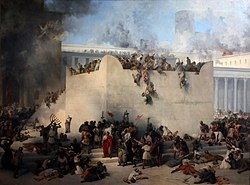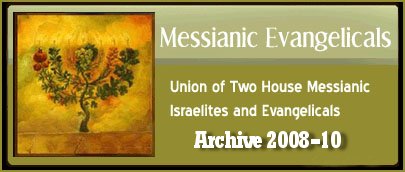Third Temple
From Wikipedia, the free encyclopedia
- This article is about a potential but unbuilt future temple. For Herod the Great's massive renovation of the Second Temple, see Herod's Temple.

Since the destruction of the Second Temple in 70 CE, religious Jews have prayed that God will allow for the building of a Third Temple. This prayer has been a formal part of the traditional thrice daily Jewish prayer services. Though it remains unbuilt, the notion of and desire for a Third Temple is sacred in Judaism, particularly Orthodox Judaism, as an unrealized place of worship. The prophets in the Tanakh called for its construction, to be fulfilled in the Messianic era.
Unused ancient Jewish floor plans for a Temple exist in various sources, notably in Chapters 40-47 of Ezekiel (Ezekiel's vision pre-dates the Second Temple) and in the Temple Scroll discovered at Qumran among the Dead Sea Scrolls.
Contents |
Role in Orthodox Judaism

Orthodox Judaism believes in the rebuilding of a Third Temple and the resumption of sacrificial worship, although there is disagreement about how rebuilding should take place or exactly what kind of worship will occur. Orthodox authorities generally believe that rebuilding should occur in the era of the Jewish Messiah at the hand of Divine Providence, although a minority position, following the opinion of Maimonides, holds that Jews should endeavor to rebuild the temple themselves, whenever possible[1]. Orthodox authorities generally predict the resumption of the complete traditional system of sacrifices, but some authorities have disagreed. It has traditionally been assumed that some sort of animal sacrifices would be reinstituted, in accord with the rules in Leviticus and the Talmud. This belief is embedded in Orthodox liturgy. Every Orthodox prayer service contains prayers for the Temple's restoration and for sacrificial worship's resumption, and every day there is a recitation of the order of the day's sacrifices and the psalms the Levites would have sung that day.
The generally accepted position among Orthodox Jews is that the full order of the sacrifices will be resumed upon the building of the Temple. Although Maimonides wrote in his early work "A Guide for the Perplexed" "that God deliberately has moved Jews away from sacrifices towards prayer, as prayer is a higher form of worship," his definitive book "The Mishneh Torah" - which is considered by some to have the force of law - states that animal sacrifices will take place in the third temple, and details how they will be carried out. Some attribute to Rabbi Abraham Isaac Kook, the first chief rabbi of the Jewish community in Palestine, the view that animal sacrifices will not be reinstituted. It should be noted that Rav Kook's views on the Temple service are sometimes misconstrued (for example, in Olat Re'ayah, commenting on the prophecy of Malachi ("Then the grain-offering of Judah and Jerusalem will be pleasing to God as in the days of old and as in former years" [Malachi 3:4]), he indicates that only grain offerings will be offered in the reinstated Temple service, while in a related essay from Otzarot Hare'ayah he suggests otherwise).
[edit] Role in prayer
Orthodox Jewish prayers include, in every prayer service, a prayer for the reconstruction of the Temple and resumption of sacrifices. The morning prayer service also includes a study session of the daily Temple ritual and offerings as a reminder, including detailed study of the animal sacrifices and incense offerings. The service also contains the daily and special-occasion psalms the Levites used to sing in the Temple. Following the weekday Torah reading there is a prayer to "restore the House of our lives and to cause the Shekhinah (Divine Presence) to dwell among us", and the Amidah contains prayers for acceptance of "the fire-offerings of Israel" and ends with a meditation for the restoration of the Temple. ("And may the grain-offering of Judah and Jerusalem be pleasing, as in former days and ancient times" (Malachi 3:4). In addition, the theological and poetic language of Hebrew is filled with words with dual connotations, which are both literal references to elements of Temple architecture or ritual, and also have metaphorical theological and poetic meanings regarding the relationship between the worshipper and God. Translations and commentary on prayers with this language tend to discuss both meanings in Orthodox Judaism. (Examples of dual-meaning words: deshen refers to both the ashes left after a burnt-offering, and also means "acceptance with favor"; kodesh refers to "the Holy", i.e. the Sanctuary portion of the Temple, and also means "holy" generally; and chatzrot refers to the courtyards of the Temple, and also connotes nearness to God; "korban" means both "sacrifice" and "drawing near".
Preservation of Kohanim and Levi'im
Orthodox Judaism preserves the Kohanim, descendants of the priestly family of Aaron, and Levi'im (Levites), descendants of the tribe of Levi, intact for future service in a restored Temple. Kohanim and Levites are regarded as still being dedicated to Divine service and obligated to report for duty for service in the Temple, at any moment, should it be rebuilt. Kohanim are still subject to Biblical purity restrictions including a prohibition on marrying a divorcee or proselyte and restrictions on entering cemeteries.
Preservation of daily cycle
Orthodox Judaism's required daily prayers must be said at the times when corresponding sacrifices would have been offered in the Temple.
Preservation of rules of tumah
The Temple had elaborate rules of ritual purity forbidding entry to people with Tumah, ritual impurity, arising from contact with the dead, seminal emissions and menstrual blood, contact with non-kosher (unclean) animals, certain diseases, and a number of other sources. While many of the original purification ceremonies involved (such as the Red Heifer ceremony) became impossible in the absence of the Temple and its rites, Rabbinic Judaism, and later Orthodox Judaism, considered Jews obligated to observe such laws of ritual purity as are possible, and retained a large number of the rules as principles for ordinary life. The laws of "family purity" are directly based, in function and terminology, on the Temple rules. A number of other requirements, such as the practices of immersing in a mikvah before Yom Kippur, washing the hands in the morning, before meals, and after a funeral, derive from these principles. Many contemporary and seemingly unconnected rules for ordinary living are intimately linked with these Temple rituals and rules. For example, the Shema Yisrael prayer is said at the time of day when Kohanim who were Tamei completed a portion of their purification ritual, and the kind of plant material that can be put on the roof of a contemporary Sukkah is the kind that is not susceptible to Tumah. In addition, authorities who permit Jews to ascend the Temple Mount require observance of a larger set of ritual purity rules than have been retained in daily life, such as a requirement of immersion following a seminal emission.
Role in Conservative Judaism
Conservative Judaism believes in a Messiah and in a rebuilt Temple, but does not believe in the restoration of sacrifices. Accordingly, Conservative Judaism's Committee on Jewish Law and Standards has modified the prayers. Conservative prayerbooks call for the restoration of Temple, but do not ask for resumption of sacrifices. The Orthodox study session on sacrifices in the daily morning service has been replaced with the Talmudic passages teaching that deeds of loving-kindness now atone for sin. In the daily Amidah prayer, the central prayer in Jewish services, the petitions to accept the "fire offerings of Israel" and "the grain-offering of Judah and Jerusalem" (Malachi 3:4) are removed. In the special Mussaf Amidah prayer said on Shabbat and Jewish holidays, the Hebrew phrase na'ase ve'nakriv (we will present and sacrifice) is modified to read to asu ve'hikrivu (they presented and sacrificed), implying that sacrifices are a thing of the past. The prayer for the restoration of "the House of our lives" and the Shekhinah to dwell "among us" in the weekday Torah reading service is retained in Conservative prayer books, although not all Conservative services say it. In Conservative prayer books, words and phrases that have dual meaning, referring to both Temple features and theological or poetic concepts, are generally retained. However, translations and commentaries generally refer to the poetic or theological meanings only. Conservative Judaism also takes an intermediate position on Kohanim and Levites, preserving patrilineal tribal descent and some aspects of their roles, but lifting restrictions on who Kohanim are permitted to marry.
In recent responsa on the subject of the role of Niddah in Conservative Judaism, a majority of the Committee on Jewish Law and Standards expressed the view that principles of ritual purity relevant to entry into the Temple are no longer applicable to contemporary Judaism and accepted a proposal to change the term "family purity" to "family holiness" and to explain the continuing observence of Niddah on a different basis from continuity with Temple practices. The Committee also permitted retention of existing observances, terminology, and rationale.[1].[2][3]
Role in Reform and Reconstructionist Judaism
Reform and Reconstructionist Judaism do not believe in the rebuilding of a Temple or a restoration of Temple sacrifices or worship. They regard the Temple and sacrificial era as a period of a more primitive form of ritual which Judaism (in their view) has evolved out of and should not return to. They also believe a special role for Kohanim and Levites represents a caste system incompatible with modern principles of egalitarianism, and do not preserve these roles. Furthermore, there is a Reform view that the shul or synagogue is a modern Temple; hence, "Temple" appears in numerous congregation names in Reform Judaism. Indeed, the re-christening of the synagogue as "temple" was one of the hallmarks of early Reform in 19th century Germany, when Berlin was declared the new Jerusalem, and Reform Jewry sought to demonstrate their staunch German nationalism. The Anti-Zionism that characterized Reform Judaism throughout most of its history subsided somewhat with the Holocaust in Europe and the later successes of the modern state of Israel. As of yet, however, the belief in the return of the Jews to the Temple in Jerusalem is not part of mainstream Reform Judaism.
Ancient attempts at rebuilding
The Bar Kochba revolt
The forces of Shimon ben Kosba, more commonly known as Simon bar Kokhba, captured Jerusalem from the Romans in 132, and construction of a new temple began, as well as renewed temple services. The failure of this revolt led to the writing of the Mishna, as the religious leaders believed that the next attempt to rebuild the temple might be centuries away and memory of the practices and ceremonies would be lost otherwise.
Julian's Roman "Third Temple"
There was an aborted project by the Roman emperor Julian (361-363) to allow the Jews to build a "Third Temple", part of Julian's empire-wide program of restoring/strengthening local religious cults. Rabbi Hilkiyah, one of the leading rabbis of the time, spurned Julian's money, arguing that gentiles should play no part in the rebuilding of the temple. According to various sources of that time (including the pagan historian and close friend of Julian, Ammianus Marcellinus[4]) the project of rebuilding the temple was aborted because each time the workers were trying to build the temple, using the existing substructure, they were burned by terrible flames that were coming from inside the earth and an earthquake negated what work was made. Shortly thereafter, Julian was killed in battle, and the Christians reasserted control over the empire.
The Sassanid vassal state
In 610, Sassanid Empire of Iran drove the Byzantine Empire out of the Middle East with the help of the Jews of Babylonia, who were given governorship of Palestine. With Jewish control of Jerusalem, the church on the temple mount was torn down and construction began on a new temple, along with sacrificial services as set down in the Mishna.
Shortly before the Byzantines took the area back, the Persians gave control to the Christian population, who tore down the partly built edifice and turned it into a garbage dump,[5] which is what it was when the Caliph Omar took the city in the 630s.
In 1267 Nahmanides wrote a letter to his son. It contained the following references to the land and the Temple:
- What shall I say of this land . . . The more holy the place the greater the desolation. Jerusalem is the most desolate of all . . . There are about 2,000 inhabitants . . . but there are no Jews, "for after the arrival of the Tartars, the Jews fled, and some were killed by the sword. There are now only two brothers, dyers, who buy their dyes from the government. At their place a quorum of worshippers meets on the Sabbath, and we encourage them, and found a ruined house, built on pillars, with a beautiful dome, and made it into a synagogue . . . People regularly come to Jerusalem, men and women from Damascus and from Aleppo and from all parts of the country, to see the Temple and weep over it. And may He who deemed us worthy to see Jerusalem in her ruins, grant us to see her rebuilt and restored, and the honor of the Divine Presence returned.
Current efforts to rebuild the Temple
Although in mainstream Orthodox Judaism the rebuilding of the Temple is generally left to the coming of the Jewish Messiah and to Divine Providence, a number of organizations, generally representing a small minority of even Orthodox Jews, have been formed with the objective of realizing the immediate construction of a Third Temple in present times. These organizations include:
Organizations involved
- The Temple Mount and Eretz Yisrael Faithful Movement states that its goal is to build the Third Temple on the Temple Mount (Mount Moriah).
- The Temple Institute states that its goal is to build the Third Temple on Mount Moriah. The Temple Institute has already made several items to be used in the Third Temple. (See below for list).
- Recently an organization known as Revava, ambitious to build the Third Temple, has planned numerous ascensions of the Temple Mount. Revava last held a rally at the Western Wall on April 10, 2005 after it announced plans to bring 10,000 Jews to the Mount. This prompted counter-protests by Palestinians in the West Bank, Gaza and on the Temple Mount, and by more than 100,000 Muslims in Indonesia and several other Muslim countries. An estimated 200 Jewish protesters were allowed past intense security during the Revava rally, and they did not ascend the Mount.
continued in next window....







